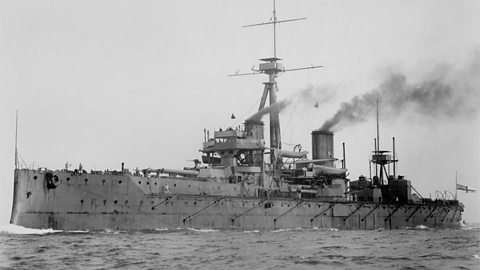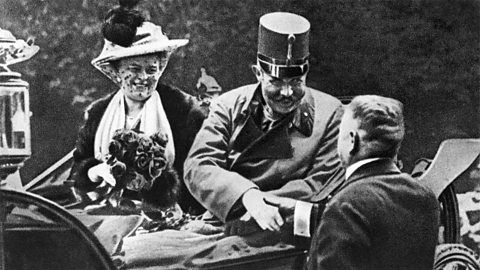Key points
- In 1914, the most powerful countries in Europe went to war with each other.
- World War One lasted for four years, from 1914 тАУ 1918, and resulted in the deaths of millions of people.
- Some of the causes of the war dated back to the 1800s and long-term tensions.
Causes of World War One activity
Learn more about some of the causes of World War One with this activity.
Empires
In 1900, the UK had the largest empireA group of countries controlled by one ruling country or leader. in the world, ruling over 400 million people spread across the UK, Africa and Asia. While people around the world had different experiences of the empire, it brought the UK huge amounts of wealth and power. France also had a large empire, making them a powerful European rival for the UK.
Germany was a relatively new country, formed in 1871. They had ambitions to grow an empire to compete with France and the UK. Kaiser Wilhelm II made a famous speech in Hamburg in 1901, saying he wanted Germany to have тАШa place in the sun.тАЩ
GermanyтАЩs ambition concerned the UK and France, as they started to see them as a potential threat. Germany interfered in French attempts to coloniseTo take over another country and rule over it. Morocco in 1911, sending a gunboatA ship armed with weapons. called The Panther to Agadir, on the Moroccan coast. Germany was eventually forced to back down, but they had shown their intent to challenge the UK and France.
The Alliances
In 1882, Germany, Austria-HungaryAustria and Hungary joined together in 1867, forming a large and powerful union in central Europe. They split into two separate countries in 1918. and Italy entered into an agreement known as the Triple Alliance. Germany had been at war with France in 1871 and feared further conflict. The Triple Alliance meant the three countries promised to defend each other if one of them was attacked.
The Triple Alliance created suspicion in other European countries. In 1894, France and Russia signed an agreement to support each other, forming the Franco-Russian Alliance, as they feared the strength of the Triple Alliance.
In 1904, the UK and France signed the Entente CordialeAn agreement signed by Britain and France on 8th April 1904. It marked the end of almost a thousand years of conflict between the two countries and paved the way for a united approach against German pressures in the decade before World War One.. This was important as they had been rivals for centuries. The fact that the UK and France were willing to put aside their differences shows how concerned they were about the ambition of Germany.
The Triple EntenteAgreement between the UK, Russia and France to work together and support each other. It did not necessarily guarantee they would go to war if one of the members was attacked. was formed in 1907, including the UK, France and Russia. It was a friendly agreement, and the three members did not necessarily guarantee to go to war to support each other. This was significant when Germany made the Schlieffen Plan, as they did not believe the UK would go to war if France was attacked. The Triple Entente was strategically in a better position, as they encircled the countries in the Triple Alliance. This caused a problem for Germany and led to them creating the Schlieffen Plan to try and deal with this threat.
What was the Schlieffen Plan?
With France to the east and Russia to the west, Germany was surrounded by countries who had united against them in the Triple Entente. Germany created a plan to avoid fighting on their eastern and western fronts at the same time. They planned to invade France by going through Belgium and then circling back to fight Russia on the eastern front. This was called The Schlieffen Plan.
The Schlieffen plan made several assumptions:
- There would be minimal resistance from Belgium.
- Russia would take six weeks to mobilise their army.
- The UK would not get involved.
The plan failed, because:
- The Belgian army managed to slow the German advance, giving the French time to move their army to the border with Belgium.
- Russia mobilised their army in ten days, meaning Germany had to move soldiers to the eastern front.
- The UK declared war on Germany, honouring the Treaty of London, signed in 1839, that said Belgium should be a neutral country. The UK was also concerned about Germany winning control of Belgian ports, giving them a base to invade from.
Having failed with their plan for a quick victory, the German army decided to hold their position, digging 400 miles of trenches from the English Channel to the border with Switzerland. This was to protect soldiers from heavy artillery and machine gunfire.
Activity - Alliances
The Naval Race
In order to build an empire, Germany needed to expand their navy to be able to travel across the seas to other countries.
This was a threat to the UK, who at the time had the biggest navy in the world. They had adopted a тАШtwo-powerтАЩ standard, meaning they wanted their navy to be at least as big as the second and third biggest navies combined. Because the UK is an island, a navy was more important than an army for defence. They had a small standing army, compared to the size of France, Russia, Germany and Austria-Hungary, but their navy was significantly more powerful.
This led to a naval race, with countries across Europe building up bigger and more powerful weapons and ships. The UK launched HMS Dreadnought in 1906, which was seen as the first modern battleship, and sparked a naval race with Germany, who wanted to challenge the UKтАЩs navy. Future ships built in this style were referred to as Dreadnoughts.

The Assassination of Franz Ferdinand
In 1908, Austria-Hungary had annexAdding more land to a country by taking it from another. Bosnia. This angered many Bosnian people, who had wanted to join with Serbia, which was also a Slavic country.
In 1914, a group was formed called the Black Hand. The Black Hand was a group of Serbians who wanted Austria-Hungary to leave Bosnia and planned to assassinate the heir to the Austrian throne, Archduke Franz Ferdinand, the nephew of Austria-HungaryтАЩs emperor Franz Joseph.
On 28 June, Ferdinand was visiting Sarajevo in Bosnia. The Black HandтАЩs first attempt at assassination failed when their bomb exploded and missed the car he was travelling in.
When Ferdinand ordered his car to take him to visit the injured in hospital, it drove back past one of the assassins, Gavrilo Princip. He fired two bullets, killing both Franz Ferdinand and his wife, Sophie.

The Outbreak of War
Austria-HungaryтАЩs emperor, Franz Joseph, was furious at the assassination of his nephew and heir to the throne. He issued a ten-point ultimatum to Serbia, holding them responsible for the murder. Serbia only agreed to nine of the points, so Austria-Hungary declared war.
The German Kaiser Wilhelm promised Austria-Hungary he would support them in whatever they decided to do, as part of their commitment in the Triple Alliance. This has become known as the тАШblank chequeтАЩ and could be interpreted as encouraging Franz Joseph to declare war, as he was certain of German support.
Russia entered the war on SerbiaтАЩs side. Germany followed the Schlieffen Plan which involved invading France by going through Belgium. The UK went to war to protect Belgium, because it had promised to do so in the 1839 Treaty of London, and World War One began. You can find out more about life on the front line in World War One in this guide.
Who or what do you think was the main cause for the outbreak of World War One?
Historians have often split the causes of World War One into four main reasons. You can use the word MAIN to help you remember them.
Militarism - many countries believed it was important to build large armies and navies.
Alliances - the Triple Alliance and the Triple Entente were said to have been formed to help prevent war. But in reality, they created opposing sides and conflict.
Imperialism - European nations were creating empires and coming into conflict.
Nationalism - countries wanted to show their power and strength over other countries.
It is important to look at how each reason is connected. The actions of one country often led to a response from another.
Regardless of who or what was responsible, the consequences for millions of people were extremely grave.
Test your knowledge
Teaching resources
Looking for more resources to help your students learn about history? This collection of resources and articles dives deep into the stories of World War One and how the war transformed millions of people's lives.
│╔╚╦┬█╠│ Teach has thousands of free, curriculum-linked resources to help deliver lessons - all arranged by subject and age group.
Play the History Detectives game! gamePlay the History Detectives game!
Analyse and evaluate evidence to uncover some of historyтАЩs burning questions in this game.

More on World War One
Find out more by working through a topic